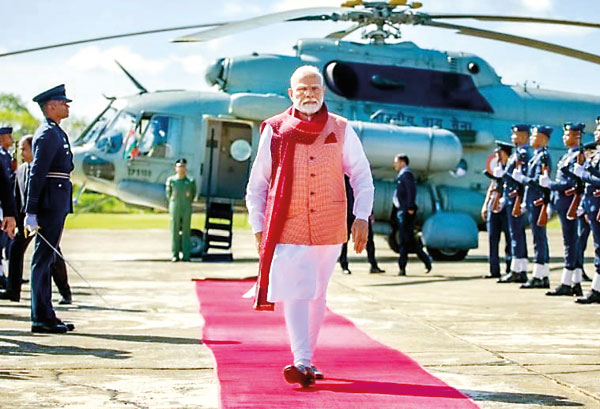Columns
He came, He saw, He quelled the fire
View(s):- How Modi suavely wooed and won islanders’ hearts with charm and style
As a mighty Caesar crossing the Rubicon, India’s Narendra Modi crossed the Palk Strait last Friday night firm in his resolve to return triumphantly home with Lanka’s Promethean fire, safely snuffed.
Earlier, the sacred primordial flame that had burnt in every Lankan’s lionheart breast, that had withstood every Chola and Pandya attempt to steal or tame, was deemed inextinguishable even by Portuguese and Dutch inquisitors.
The British had tried but had tried in vain, until at last, desperate to control the island to be used as the gateway to India, had, thanks to treachery by power-hungry feudal chiefs, covered the fire in the bellows of a covenant, with its content publicly proclaimed for the conquered to see.
And in the footsteps of his own colonial British masters, who had let trade beguile the masses before staking the Union Jack on the land, India’s superstar Modi delivered the coup de grace to quell the patriotic fire, with such aplomb, such style, such grace and such finesse that not even those who had been its fanatical guardians felt a tinge of its death nor heard its last crackle nor splutter.
But there is disquiet in the ranks of those who heard it.
Although they give due allowance to the cultural and religious legacy bequeathed through the ages by India—the pantheon of Hindu gods and the philosophy of India’s greatest son, Gauthama Buddha, whose doctrine of nonviolence had shaped and moulded the nation throughout the course of history—and were grateful to her bequests, there lurked suspicion of India’s expansion aims.
Although we owe Modi and India a vast debt of gratitude for coming to the rescue of this bankrupt island nation during her darkest night three years ago, not with tea and sympathy as most nations did but with a four billion dollar credit lifeline to make ships laden with oil, food, medicine and other essential goods return to deserted Colombo port; the need for a defence treaty between Lanka and India, signed, sealed and exchanged in a shroud of complete secrecy, and proclaimed to the Lankan people, with contents unrevealed, as a fait accompli, must give us pause.

INDIA’S NARENDRA MODI: The style, the charm, the flamboyance, all that makes India incredible, found incarnate in her Prime Minister Modi
Even at the risk of being called ingrate, the ranks of those who expressed disquiet could well forbear to cheer India’s diplomatic coup de grace, executed without a grapeshot fired.
It seems every step and site of Modi’s two-night sojourn in Lanka had been meticulously planned, right down to the last minute detail, to convey from beginning to end some sort of subliminal message to the islanders. Furthermore, to enhance its aesthetic appeal, it was brilliantly choreographed and elegantly performed to leave a lasting effect on what made India ‘incredible’.
Hours before India’s Prime Minister Modi arrived at the Katunayake Airport terminal last Friday night, an Indian naval ship, the Sahyadri, docked at Colombo Port, giving a glint of India’s immense naval power that dominated the Indian seas.
Perhaps it was not coincidental that India had insisted the Indo-Lanka Defence Pact be signed on April 5th, the day the JVP had launched the country’s first armed insurrection 54 years ago, against Indian expansion, with the cry, ‘motherland or death’. If India’s wish had been to subtly drive the point home, she couldn’t have done it in a more effective style to hit bullseye.
The Defence Treaty was duly signed on April 5th at the Presidential Secretariat. But before attending to the business agenda of the day, a welcoming ceremony was held not outside the old parliamentary compound nor even on Galle Face Green but at Independence Square, the historic site where the British granted Ceylon her independence, 78 long years ago.
Given the sensitive nature of the Indo-Lanka Defence Treaty—unprecedented in recent history—with its contents and import kept secret from the people, was the choice of Independence Square wise? When doubts raged in people’s minds, whether they had just lost it? Apart from the two national anthems played by a military band, a guard of honour and a 21-gun salute boomed from afar; little significant note took place at the symbolic site.
Then the VIP convoy headed to the Presidential Secretariat to sign the pact that had brought Modi to Lanka. After the signing ceremony had been concluded, the two leaders delivered their speeches.
The President of Sri Lanka, Anura Kumara, assured the visiting Indian Prime Minister Narendra Modi that Sri Lanka’s territory will not be used for any purpose that could undermine India’s security or regional stability.
In reply, India’s Prime Minister Modi, obviously delighted that Lanka was a true friend of India, quoting the words of Tamil saint Thiruvalluvar, said, “What could be a bigger protection against the enemy if not the shield of his friendship?”
The elated Sri Lankan President garlanded India’s Prime Minister Modi with the medal of ‘Sri Lanka Mitra Vibhushana’, the highest honour Lanka can bestow.
If that was the spirit of bonhomie that breathed within the Secretariat, then the mood on the street was worlds apart. Outside the Fort Railway Station, the 90s JVP breakaway faction, the Peratugami Front, was staging their protest against Indian expansion while the opposition resorted to social media to ask why details of the Defence Treaty, hyped as the bedrock of mutual economic cooperation, were not revealed to the people of Lanka for debate and discussion.
The people had been shown the Ramayana cover but were not allowed to read Valmiki’s epic tale.
Had the Defence Treaty effectively reduced the sovereign state of Lanka to be the 29th pranth of India and had demoted the President of Lanka to the rank of its Chief Minister? Was that the reason why it had to remain wrapped in utmost secrecy? In the absence of openness, conspiracy theories flourished like mushrooms sprouting in every nook and cranny after a night of heavy rain.
But what diehard nationalists missed most and held as the need of the hour was for a JVP in the opposition to take the anti-Indian expansion protest to the streets, as they have habitually done in the past, to sabotage, disrupt, delay and frustrate any Indian project, including the Sampur power project, brought for the country’s benefit.
For instance, last year, on April 23rd, Power Minister Kanchana charged the JVP had caused the country a loss of Rs. 32 billion by stopping the Sampur power project. In a report published in the Daily FT, he said, “If there is a political party that has continuously caused losses to power and energy generation, it is definitely the JVP.”
Oh, for a JVP at this dire hour! But they were missing in action. Alas, the opposition’s loss had become the government’s gain.
Surprisingly, or maybe not, though the details of the Defence Pact were also not revealed to the people of India, there was no din of protest, no whisper of consternation, unlike the stir it had generated in Sri Lanka. Instead, they seemed to take it in their stride with karmic acceptance, considering it simply as another feather in India’s cap, one more medal around India’s neck; another scalp to adorn their hall of trophies.
Now there was naught the diehards could do but sit down and cry, wondering if the inalienable sovereignty that resided with the people of Sri Lanka had been done for by the still undisclosed Defence Treaty? What, indeed, if they had?
To paraphrase Omar Khayyam’s Rubaiyat 51: The moving finger writes, and having writ, moves on, nor all thy suspicions nor doubts shall lure it back to cancel half a line, nor all thy fears wash out a word of the signed Defence Pact.
But the Modi roadshow was far from over, having only just begun. The best was yet to come. If Saturday had been busy attending to state affairs, Sunday early morn was when Modi let his hair down to reveal to all of Lanka the common touch of the man that had made India truly incredible with every beat of his heart.
Stepping out from an Indian military chopper to an early Anuradhapura dawn, Narendra Modi cut a dashing figure, trendily attired in a sleeveless mauve jacket and white kurta with tight white pants, and a thick red shawl, casually tossed around his neck, when he began striding down the rolled-out red carpet like a movie star to receive his Oscar.
But that day, he had arrived at the ancient city of Anuradhapura not as a Head of State, not as a leader of a billion and a half people to flaunt his power and status. He had come to Anuradhapura as a pilgrim, to humbly kneel and pay homage to the sapling of the bo tree that gave shelter to the Buddha.
As befits his role as a pilgrim to the sacred Buddhist site, there was none of the flamboyance he had displayed a few minutes back on the red carpeted tarmac of an Air Airforce base. Gone was the mauve sleeveless jacket; gone, too, was the flashy red shawl. It was replaced by a dainty white shawl with a gold sequined red border that didn’t shout but made its fashion statement in dignified silence.
From his appearance at the sacred temple befittingly in pilgrim robes, right down to his flawless conduct throughout his stay on hallowed ground, he did not put a foot wrong or do anything out of place, nor did he express hesitancy or doubt in observing religious rituals and rites but acted to the manner born.
The way he knelt before the Chief Monk in worship, and the moving manner he kept his head on the monk’s knee, seeking the Triple Gem’s blessing, the solemn reverence and worship he accorded to the Jaya Sri Maha Bodhi, left one in no doubt that here was a son of the soil—even the President of Sri Lanka—in worship before India’s treasured gift to Lanka 2300 years ago.
After jointly opening an Indian-sponsored signalling project with President Anura Kumara and flagging a train to depart, Modi flew on his Indian chopper from Anuradhapura’s Air Force base, which was made an international airport for a day by government gazette.
Modi didn’t leave on his chopper for larks but to send a clear signal of India’s future aims. He had chosen a chopper ride to fly low to gain a bird’s-eye view of the submerged rocks that remain of the Hanuman-built bridge, the Ram Sethu, that enabled—as Valmiki of Ramayana fame tells us—Rama and the Varana Army to cross the Palk Strait and land on Lanka’s shores.
Sending an X message of his sightings, he headed to Rameshwaram to inaugurate the construction of the Pamban Bridge to replace a 110-year-old structure that once connected Rameswaram to the Indian mainland.
Physical connectivity may not only be too close for comfort, as Ravana found out, but will also spell the destruction of Lanka’s island status.
Modi had backed the right horse, and India’s daring gamble had paid off. But should the JVP Government renege on its promises, they will find India’s unappeasable wrath on their Pelawatte doorstep.
Buying or selling electronics has never been easier with the help of Hitad.lk! We, at Hitad.lk, hear your needs and endeavour to provide you with the perfect listings of electronics; because we have listings for nearly anything! Search for your favourite electronic items for sale on Hitad.lk today!


Leave a Reply
Post Comment